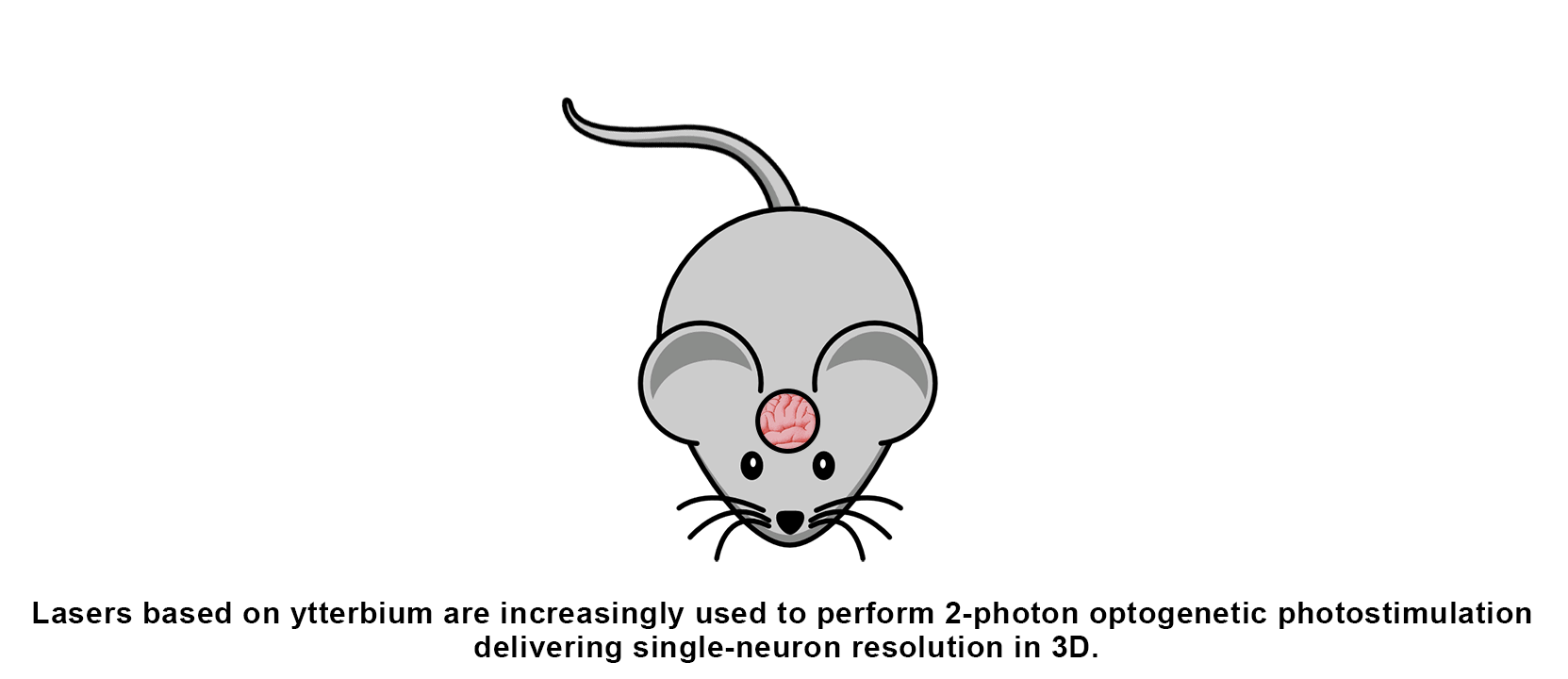What are Ytterbium lasers?
Ytterbium lasers offer several advantages over those based on other gain materials. While sometimes created as slab or disk lasers, their main impact is as fiber lasers with ultrafast output for scientific and materials processing applications.
Ytterbium (Yb) lasers are lasers where the gain medium is a host material doped with ytterbium (Yb3+) ions. They emit light in the near-infrared, somewhere between 1030 and 1070 nm, depending on the host. For mode-locked Yb lasers, this output can be efficiently frequency-double or tripled to deliver green and ultraviolet wavelengths. These mode-locked lasers can also be used to pump parametric devices to deliver wavelength-tunable output.
Four Main Advantages of Yb Lasers
The main advantages of ytterbium (Yb) lasers are:
- They can be mode-locked to deliver femtosecond (fs) output. Because of the high peak power this creates, fs pulses are well-suited to cutting-edge applications in neuroscience, as well as advanced materials processing applications.
- They can be produced as fiber lasers, resulting in operational simplicity and superior reliability, even in demanding industrial settings.
- They can be scaled to higher power better than any other fs laser. This enables brighter images and faster multiphoton excitation in neuroscience and delivers higher throughput in precision cutting, e.g., medical devices such as stents.
- They have higher electrical efficiency than other ultrafast lasers. This makes them compatible with greener manufacturing practices with greater sustainability.
Let’s now look at the technical basis of these advantages in more detail and then see how they impact a couple of representative applications.
Some “Light” Technical Reading
Mode-locking delivers short pulses and high peak power
Mode-locking is a way to make a laser produce very short pulses and very high pulse-repetition rates. It causes all the light created in a continuous-wave laser to collapse to a very short pulse that cycles around the laser cavity. Every time the pulse bounces off the partially reflecting output mirror, a fraction escapes. So the laser naturally produces a pulse rate corresponding to the cavity roundtrip time. With a laser cavity length of 10s of cm or less, this translates into a repetition rate of 10s of MHz.
On the other hand, the pulse width depends on the laser’s wavelength spread, called the “gain bandwidth.” Broader output produces shorter pulses and vice versa. The wide bandwidth of Yb means these lasers can deliver pulses as short as 50 fs, with peak powers in the gigawatt regime.
Fiber architecture provides reliability and power scalability
Fiber and power scaling are intimately linked. In any solid-state laser, a challenge is removing unwanted heat from the gain material where it can cause lensing problems and even damage. The heat has to conductively flow to the edge (surface) of the material for extraction. This limits the maximum power of solid-state lasers based on bulk crystals. But if the gain medium is stretched into a fiber or compressed into a disk, then every part of the material is near a cooled surface and cooling considerations no longer thwart power scaling.
A major advantage of Yb is that it can be hosted in glass which can be formed as either fibers or disks. However, fiber lasers have the advantage of being optomechanically robust and can’t drift out of alignment. This power scalability is why Yb fiber lasers like the Coherent Monaco continue to set new power standards for femtosecond lasers. And their inherent reliability is why they are being adopted for diverse and demanding applications.
Efficient diode laser pumping lowers carbon footprint
Yb lasers are more electrically efficient than some other solid-state lasers for two reasons. First, the diode lasers that convert electricity into light are used to directly pump the Yb doped fiber, with no intermediate step that could otherwise lower overall electrical efficiency. In addition, there is a relatively small quantum defect – the difference between the diode pump wavelength (976 nm) and the Yb fiber output wavelength (1030 to 1070 nm). The energy represented by the quantum defect is lost as heat so small values like this are very desirable.

Applications of Yb Lasers
The application areas for mode-locked Yb fiber lasers depend on their power level and output wavelength (IR, green, or UV).
Multiphoton Neuroscience
Low-power lasers with a few watts of average power are mainly used in scientific applications. Here the Yb laser is integrated in a single-box format with an optical parametric oscillator (OPO) to deliver wavelength-tunable output. An example is the Chameleon Discovery NX. By far the biggest application for these tunable sources is multiphoton microscopy which provides high-resolution 3D images for neuroscience, intravital imaging, and translational research into real-time (potentially intra-surgical) biopsies.
Higher power (10’s of watts) amplified Yb lasers include the Monaco series. The infrared versions are useful for both scientific and industrial applications. The main scientific applications are in neuroscience, where the Monaco is paired with a tunable optical parametric amplifier such as the Opera F generating a pulse width of only 50 fs. The wavelength tunable output is used for both three-photon imaging and two-photon optogenetic photostimulation.
Precision Materials Processing
The industrially packaged Monaco series brings the unique benefits of fs laser processing to a growing range of precision manufacturing applications. The infrared models – Monaco 1035 – supports applications such as glass cutting & welding, thin/film cutting, and medical device manufacturing, e.g., stents, TAVR tools.
The Monaco 517 models deliver green output, making them a good match for materials processing applications such as polymer cutting and drilling, flex PCB, and IC package cutting, silicon wafer singulation, medical device manufacturing, thin metal foil cutting, and texturing
The 345 nm ultraviolet output of the Monaco UV is used for materials processing of Flex components and for cutting a range of materials with no peripheral thermal effects: OLED modules, semiconductor wafers, thin-films, foils, and display touch sensors.